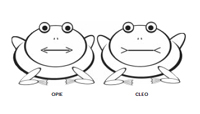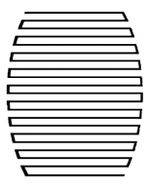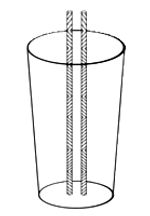
Optical Illusion
Description: Students will look at six optical illusions and discuss them with the teacher and classmates
Purpose: To introduce students to the phenomenon of optical illusions
Length of Activity: 30 minutes
Materials:
- Provide students with copies of the optical illusions shown here.
- Rulers, one per student.
- Pencil or pen (optional).
Illusion #1:

Questions:
What is happening to the train tracks in this picture? Do they meet in the distance?
What’s Going On?
The train tacks appear to come together in the distance. In reality, they don't meet at all. Although our eyes tell us that the train tracks are converging, our brain knows that they're parallel and that parallel lines never converge.
Illusion #2:

Questions:
What happens if you look at this image sideways? Do the stairs run right to left or are they upside down?
What’s Going On?
The staircase seems to flip around as the image is turned. You can see the staircase two different ways, but you can only see it one way at a time.
Illusion #3:

Questions:
Do you see separate bars or one continuous line? Trace the line with a pencil or your finger, what did you discover?
What’s Going On?
Your brain sometimes sees separate bars and sometimes it sees one continuous line. The brain is filling in information based on what it expects to see.
Illusion #4:

Questions:
Which frog has the longer mouth? Check with a ruler, what did you discover?
What’s Going On?
Both mouths are the same size. The direction of the arrows at the ends only make it seem like one mouth is larger than the other.
Illusion #5:

Questions:
Are thse straws straight? Check with a ruler, what did you discover?
What’s Going On?
Patterns change our perception. In this case, they make the straws look crooked.
Illusion #6:

Questions:
Look at the middle circles of these two flowers. Which is larger? Check with a ruler, what did you discover?
What’s Going On?
Both circles are the same size. The surrounding circles make the inner circles appear to be different. The brain is comparing the circles for us based on what it expects to find, not what is really there.